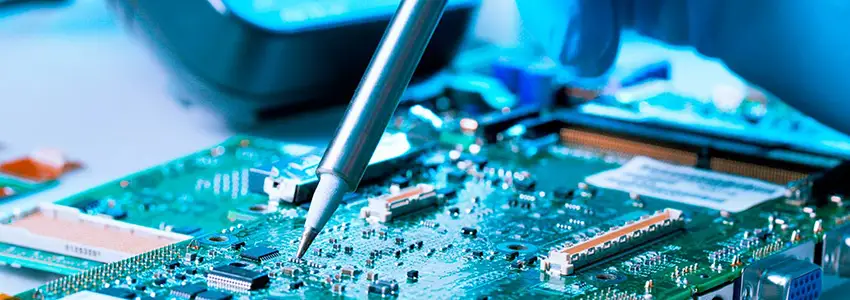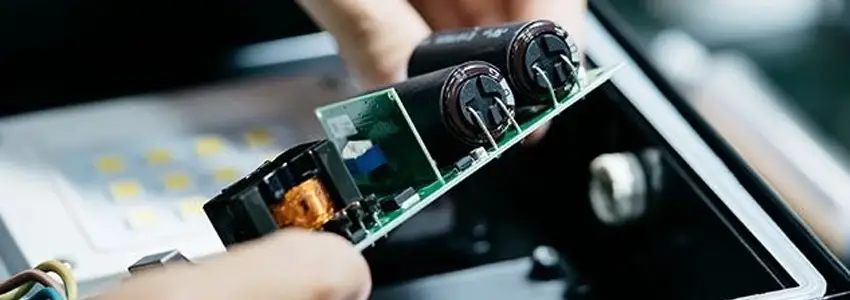- +86-0755-23597570-6067 Mon-Sun 0. 00-23. 59

Mixed PCB assembly refers to a method where both surface-mount and through-hole components are integrated onto a single circuit board. Essentially, this combines automated and manual assembly techniques. Such assemblies are particularly beneficial for products that demand a blend of densely packed and highly reliable components. Assembling mixed model PCBs can be more complex compared to standard PCBs, but the advantages often outweigh the additional time and resources required.
Fastlink excels at building complex PCB assemblies for diverse industries, incorporating mixed technologies with speed and precision. Our services in this area prioritize quality and precision, along with efficiency. We provide a comprehensive set of process and assembly choices, including work on circuit boards that are single-sided, double-sided, flexible, rigid-flex, or multi-layered with mixed technology.
Mixed technology PCB assembly merges surface mount technology (SMT), through-hole technology, and ball grid array (BGA) packaging. This method integrates Surface Mount Devices (SMD), through-hole components, and ball grid packages, harnessing the strengths of all three technologies. This approach is frequently employed in applications that demand a blend of these component types. A significant benefit of this PCB assembly style is the elimination of solder paste usage. This can effectively address various soldering challenges.
Advantages of Mixed Assembly PCBs
1. Versatility in Component Integration: Mixed PCBs allow for the integration of a wide range of components. SMT components are ideal for miniaturization and high-density designs, while THT components offer better mechanical strength. This versatility is especially beneficial for complex electronic devices.
2. Enhanced Reliability: Through-hole components offer superior mechanical bonds, making mixed assembly PCBs more reliable in environments subjected to stress or heat. This is critical for high-power applications or devices that experience physical stress.
3. Design Flexibility: Mixed assembly enables designers to optimize the layout by placing components according to their function and connectivity, rather than being constrained by the assembly method. This can lead to more efficient designs and better performance.
4. Optimized for Functionality: Certain components are only available in through-hole packages, or perform better in such configurations. Mixed assembly allows for the inclusion of these components, ensuring optimal functionality of the final product.
5. Heat Management: Through-hole components can handle more heat than SMT components. This is beneficial for high-power applications or in scenarios where heat dissipation is a concern.
1. Increased Manufacturing Complexity: The process of assembling a mixed technology PCB is more complex than using a single technology. This can lead to longer production times and higher labor costs.
2. Higher Cost: The added complexity and the requirement for multiple assembly processes (like wave soldering for THT and reflow soldering for SMT) typically make mixed assembly PCBs more expensive.
3. Design Challenges: Balancing the placement of SMT and THT components can be challenging. This might require more sophisticated design tools and skilled engineers, adding to the cost and time of development.
4. Size Limitations: While SMT components allow for miniaturization, the inclusion of THT components can limit how small the PCB can be made. This might be a drawback in applications where space is at a premium.
5. Soldering Challenges: The need to avoid damaging SMT components during the wave soldering process used for THT components can be challenging. This may require special techniques like adhesive bonding of SMT components or the use of solder pallets.
6. Limited Revision Capability: Once a through-hole component is soldered, making revisions or repairs can be more difficult and risk damaging the PCB, as opposed to SMT components which are easier to rework.

Through-hole assembly involves placing components with leads into drilled holes on a circuit board and securing them with solder. This method contrasts with surface mount technology, as the leads pass “through” the board. Dominant until the late eighties, THA still plays a role in modern electronics manufacturing, complementing SMT in specific applications. It’s particularly useful for large components (like inductors and capacitors), parts under mechanical stress (such as switches and connectors), and in high-performance electronics (like relays or high voltage resistors). THA’s main advantage lies in the robust connections it forms, making it suitable for components facing mechanical, environmental stress, or high temperatures. Additionally, its ease of modification makes THA favorable for prototyping and amateur projects.
SMT is the process of mounting electronic components directly onto the surface of a PCB using solder paste. This method involves automated equipment for precise placement and mounting, offering several benefits. SMT facilitates rapid installation of parts, boosting production while reducing costs. It allows for the use of smaller, lighter components, enabling designers to optimize PCB space and minimize product size without sacrificing performance. The reduction in weight also enhances product portability. SMT is known for allowing higher power components, achieving high component density, and providing a smaller overall footprint, all while ensuring a simple and reliable PCB assembly process.
BGA represents a significant leap in surface mount technology (SMT) packaging. This method features numerous spherical bumps on the component’s surface, enabling high-density packaging. BGA allows for the compact packaging of ICs with hundreds of pins, enhancing functionality while conserving space. Key advantages of BGA include its excellent electrical properties, thermal conductivity, and improved solderability, which contribute to high manufacturing yields. Its application spans various industries including wireless, medical, LED, and sectors like aerospace, telecommunications, and the military.
Mixed PCB Assembly is particularly useful for high-density applications where high functionality is required in a compact space. Here are some key areas where mixed-model PCB technology is applied:
● Server Boards
● Video Processing Units
● Communication Hardware
● Sensor Boards
● Timer-Based Water Sprinklers
● Air Conditioners
● LED Lighting Products
● Tablets
● Wearable Devices
● Industrial Control Systems
● Infrared Remote-Controlled Televisions
● Smartphone accessories
● processor
● Timer based sprinklers
● Automatic dispensing machine
● Acoustic scanning microscope
● Template printing machine
At Fastlink, we offer a range of mixed technology PCB assembly services and capabilities:
● Fully Automated Assembly Equipment: Our facility is equipped with state-of-the-art, fully automated machinery for assembling PCBs.
● Rapid Production and Prototyping: We specialize in delivering both quick turn production builds and prototypes to meet diverse client needs.
● High-Speed Production Capacity: Our capability for high-speed production allows us to efficiently manufacture densely populated assemblies.
● Precision Component Placement: Our advanced machines excel at placing small, thin, lead components on circuit boards with remarkable accuracy and speed.
● Cutting-Edge Machinery Features: We offer laser sighting and automated flux dispensing, thanks to our sophisticated machinery.
● Diverse Soldering Techniques: Our facility is equipped with machines for selective and wave soldering, catering to a variety of assembly requirements.
● Automated Multi-Stage Aqueous Cleaning: We ensure thorough cleaning of PCBs with our fully automated multi-stage aqueous cleaning system.
● Comprehensive Testing and Inspection: Every PCB assembly undergoes rigorous testing and inspection using methods such as X-ray inspection, Automated Optical Inspection (AOI), and functional testing.
● Use of Titanium Stiffeners: To enhance rigidity, we can incorporate titanium stiffeners in the assembly process.
● Flexible Volume Options: Our services cater to various volume requirements, including prototypes, small runs, and large-scale production.
We offer a range of PCB assembly services. This includes both single and double-sided mixed PCB assembly, we can easily handle high-mix complex PCB assemblies. Additionally, we have the capacity to handle both prototype quantities and large-scale production, accommodating all your volume needs. Choosing Fastlink will be the right decision for you.